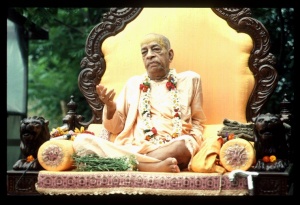CC Antya 5.20 (1975): Difference between revisions
(Vanibot #0027: CCMirror - Mirror CC's 1996 edition to form a basis for 1975) |
(Vanibot #0020: VersionCompareLinker - added a link to the Version Compare feature) |
||
| Line 2: | Line 2: | ||
<div style="float:left">'''[[Sri Caitanya-caritamrta (1975)|Śrī Caitanya-caritāmṛta (1975)]] - [[CC Antya (1975)|Antya-līlā]] - [[CC Antya 5 (1975)|Chapter 5: How Pradyumna Miśra Received Instructions from Rāmānanda Rāya]]'''</div> | <div style="float:left">'''[[Sri Caitanya-caritamrta (1975)|Śrī Caitanya-caritāmṛta (1975)]] - [[CC Antya (1975)|Antya-līlā]] - [[CC Antya 5 (1975)|Chapter 5: How Pradyumna Miśra Received Instructions from Rāmānanda Rāya]]'''</div> | ||
<div style="float:right">[[File:Go-previous.png|link=CC Antya 5.19 (1975)|Antya-līlā 5.19]] '''[[CC Antya 5.19 (1975)|Antya-līlā 5.19]] - [[CC Antya 5.21 (1975)|Antya-līlā 5.21]]''' [[File:Go-next.png|link=CC Antya 5.21 (1975)|Antya-līlā 5.21]]</div> | <div style="float:right">[[File:Go-previous.png|link=CC Antya 5.19 (1975)|Antya-līlā 5.19]] '''[[CC Antya 5.19 (1975)|Antya-līlā 5.19]] - [[CC Antya 5.21 (1975)|Antya-līlā 5.21]]''' [[File:Go-next.png|link=CC Antya 5.21 (1975)|Antya-līlā 5.21]]</div> | ||
{{CompareVersions|CC|Antya 5.20|CC 1975|CC 1996}} | |||
{{RandomImage}} | {{RandomImage}} | ||
==== TEXT 20 ==== | ==== TEXT 20 ==== | ||
<div class="verse"> | <div class="verse"> | ||
:sevya- | :sevya-bujhi āropiyā karena sevana | ||
:svābhāvika dāsī-bhāva karena āropaṇa | :svābhāvika dāsī-bhāva karena āropaṇa | ||
</div> | </div> | ||
| Line 18: | Line 17: | ||
<div class="synonyms"> | <div class="synonyms"> | ||
sevya- | sevya-bujhi āropiyā—considering worshipable; karena sevana—engages in service; svābhāvika—by his natural position; dāsī-bhāva—as a maidservant; karena āropaṇa—considers. | ||
</div> | </div> | ||
| Line 32: | Line 31: | ||
<div class="purport"> | <div class="purport"> | ||
Śrīla Bhaktivinoda Ṭhākura writes in his Amṛta-pravāha-bhāṣya: | Śrīla Bhaktivinoda Ṭhākura writes in his Amṛta-pravāha-bhāṣya: "Śrīla Rāmānanda Rāya composed a drama named Jagannātha-vallabha-nāṭaka, and he engaged two young girls who were professional dancers and singers to demonstrate the ideology of the drama. Such girls, who are called deva-dāsīs, are still employed in the temple of Jagannātha, where they are called māhārīs. Śrī Rāmānanda Rāya engaged two such girls, and because they were meant to play the parts of gopīs, he taught them how to awaken thoughts like those of the gopīs. Because the gopīs are worshipable personalities, Rāmānanda Rāya, who considered the two girls gopīs and himself their maidservant, engaged in their service by massaging their bodies with oil to cleanse them completely. Because Rāmānanda Rāya always placed himself in the position of a maidservant of the gopīs, his rehearsal with the girls was actually on the spiritual platform." | ||
Because there was no question of personal sense gratification when Śrī Rāmānanda Rāya was serving the girls, his mind was steady and his body untransformed. This is not to be imitated, nor is such a mentality possible for anyone but Śrī Rāmānanda Rāya, as Śrī Caitanya Mahāprabhu will explain. The example of Śrī Rāmānanda Rāya is certainly unique. The author of Śrī Caitanya-caritāmṛta has given this description because in perfect devotional service one can attain such a position. Nevertheless, one must understand this subject very seriously and never attempt to imitate such activities. | Because there was no question of personal sense gratification when Śrī Rāmānanda Rāya was serving the girls, his mind was steady and his body untransformed. This is not to be imitated, nor is such a mentality possible for anyone but Śrī Rāmānanda Rāya, as Śrī Caitanya Mahāprabhu will explain. The example of Śrī Rāmānanda Rāya is certainly unique. The author of Śrī Caitanya-caritāmṛta has given this description because in perfect devotional service one can attain such a position. Nevertheless, one must understand this subject very seriously and never attempt to imitate such activities. | ||
</div> | </div> | ||
Latest revision as of 02:32, 27 January 2020

A.C. Bhaktivedanta Swami Prabhupada
TEXT 20
- sevya-bujhi āropiyā karena sevana
- svābhāvika dāsī-bhāva karena āropaṇa
SYNONYMS
sevya-bujhi āropiyā—considering worshipable; karena sevana—engages in service; svābhāvika—by his natural position; dāsī-bhāva—as a maidservant; karena āropaṇa—considers.
TRANSLATION
Śrīla Rāmānanda Rāya used to act in that way because he thought of himself in his original position as a maidservant of the gopīs. Thus although externally he appeared to be a man, internally, in his original spiritual position, he considered himself a maidservant and considered the two girls gopīs.
PURPORT
Śrīla Bhaktivinoda Ṭhākura writes in his Amṛta-pravāha-bhāṣya: "Śrīla Rāmānanda Rāya composed a drama named Jagannātha-vallabha-nāṭaka, and he engaged two young girls who were professional dancers and singers to demonstrate the ideology of the drama. Such girls, who are called deva-dāsīs, are still employed in the temple of Jagannātha, where they are called māhārīs. Śrī Rāmānanda Rāya engaged two such girls, and because they were meant to play the parts of gopīs, he taught them how to awaken thoughts like those of the gopīs. Because the gopīs are worshipable personalities, Rāmānanda Rāya, who considered the two girls gopīs and himself their maidservant, engaged in their service by massaging their bodies with oil to cleanse them completely. Because Rāmānanda Rāya always placed himself in the position of a maidservant of the gopīs, his rehearsal with the girls was actually on the spiritual platform."
Because there was no question of personal sense gratification when Śrī Rāmānanda Rāya was serving the girls, his mind was steady and his body untransformed. This is not to be imitated, nor is such a mentality possible for anyone but Śrī Rāmānanda Rāya, as Śrī Caitanya Mahāprabhu will explain. The example of Śrī Rāmānanda Rāya is certainly unique. The author of Śrī Caitanya-caritāmṛta has given this description because in perfect devotional service one can attain such a position. Nevertheless, one must understand this subject very seriously and never attempt to imitate such activities.